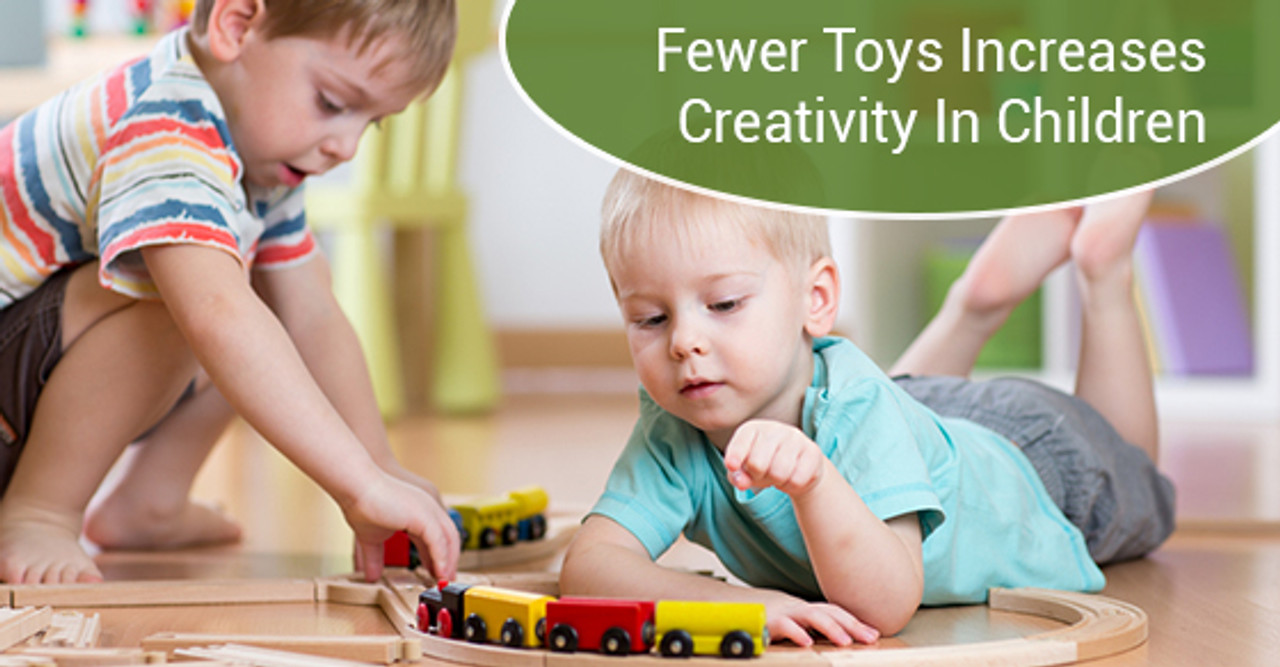How Fewer Toys Can Increase Creativity in Children
Every parent knows that toys are a necessary part of childhood development, but how many toys does a child really need? If you were to survey most parents, you are bound to hear a war-story or two about tripping over toys in the middle of the night. While painful, this is simply the result of toy bins inevitably filling up as children age and mature from their earlier toys.
With less space and more clutter, parents can find their homes riddled with toy obstacles, that can sometimes feel placed with militaristic precision. If this sounds like your home don't worry, you are not alone. Luckily, some new studies might help shed light on how many toys your family really should have. Additionally, we will make some suggestions to help you make those tough decisions and ultimately focus on quality over quantity when it comes to toys.
Are More Toys Better?
A recent study from the University of Toledo has suggested that having too many toys can actually decrease the quality of children's play. In fact, it goes as far as recommending that having fewer, higher quality toys can increase creativity, focus, and encourage imaginative play.
The study was conducted by observing over 36 children and aimed to gauge the engagement levels compared to the number of toy options available. The results were surprising to some, as in the end, it seemed time and time again the children would exhibit higher quality interactions when surrounded by fewer toys.
This is a common sentiment for a lot of parents. While they will spend hundreds, if not thousands on the latest toys, children don't always gravitate towards the gizmo with the most amount of buzz.
Quality Over Quantity
This why it is important for parents to introduce toys that stimulate learning and serve educational purposes early in development. If you focus on limiting your child's playtime to toys based on developing particular skills you can ensure higher value, more educational experiences. While this is true, before you rush to the donation bin to clear out your excess toys, there are some other things that you should consider.
Declutter Your Collection
While it can be difficult to reduce your family's toy collection, this isn't always the result of your kids themselves. Often parents can attach an unrealistic sentimental value to every toy from early childhood. Although there is nothing wrong with saving mementoes from this precious time, it's impossible to save everything. Try not to save something just because of what it cost. There is a difference between price and value. If it doesn't carry any value, get rid of it. Additionally, if it only carries value with you and not the children, ask yourself: why are you saving it?
Another great tip is to start you off is to think about the last time the toy was used. Has it been weeks, months, years? A good rule of thumb is that if it hasn’t been used in more than six months, it could be time to donate or remove.
Importance of Imagination
At Thinkamajigs, we are all proponents of toys that stimulate learning directly. We understand how educational toys are vital to the development of children. While this is true, removing all toys that aren't strictly educational isn’t the best idea.
In many studies, the importance of pretend play and imagination is just as crucial to development as educational items. While make-believe and role-playing can seem like a by-product of growth, it is crucial to the development of children. When you’re decluttering, avoid throwing away toys that you know inspire pretend play. This may be harder than it sounds, but by watching how your child interacts with their toys, you should be able to see which toys are being employed in positive pretend play.
You will want to remove toys with negative pretend play tendencies. This could be the result of violence, materialism, or other bad habits. The important thing to realize is that each child will interact with every toy differently. Observe how your child interacts with their toys and don't be afraid to make a judgement call.
Organize & Improve Development
While decluttering your hallway may save your toes and ankles from inevitable injuries, decreasing your child's number of toys could have a staggering impact. With a more focused collection of toys, parents can increase the quality of playtime with improved interaction, creativity, and engagement.
To learn more about quality educational materials, that can help stimulate learning, contact Thinkamajigs or take a look through our online store to discover our selection of quality teaching materials, educational toys, and games!
LATEST BLOG POSTS
How To Set Up A Montessori Environment At Home
Creating a Montessori-inspired environment at home provides the opportunity to support your child's...
Montessori & Technology: do they play well together?
Dr. Maria Montessori’s method of teaching children emphasizes the use of concrete materials and hand...
Froebel Gifts: An Introduction
You may have heard of Fröebel Gifts (we carry the full selection here), but you may also wonder what...
Safe Toys for Toddlers: What Parents Should Know
As a parent, you want to be sure that any toys your toddler plays with are safe and age-appropriate....
Infant & Toddler Toy Guide - Part 2
THINKAMAJIGS’ GUIDE TO CHOOSING EDUCATIONAL TOYS FROM BIRTH TO AGE 3PART 2: AGE-RELATED DEVELOPMENTA...
Infant & Toddler Toy Guide - Part 1
THINKAMAJIGS’ GUIDE TO CHOOSING EDUCATIONAL TOYS FROM BIRTH TO AGE 3PART 1: SKILLS DEVELOPMENT“What...







